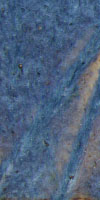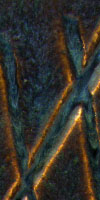
Cone 6 Iron Reds | Matte Bases | Glossy Bases | Honey Transparents | Floating Blues | PV Clay - Cone 06 Raku | LowFire Clear
Floating Blue Gerstley Borate Cone 6 Glazes
These pages were a study of how we substituted Boraq 1, Boraq 2 and Boraq 3 into common recipes.
Boraq was developed by Plainsman Clays as a substitute for Gerstley Borate (under code number L3127E).
The development effort took place during the early 2000s, the initial period when the demise of Gerstley Borate appeared imminent.
Other companies, including Laguna Clays, introduced similar products at the time.
Later Laguna Clays began processing a last stockpile of the material they found at the mine and interest in substitutes waned.
In 2023 the cycle appears set to repeat so these pages are pertinent again.
Floating Blue (also called Blue Hare's Fur) is probably the most well known
and popular cone 6 pottery glaze. It was popularized by the book The Potter's Complete Book of Clay and Glazes by James Chappell. It uses nepheline syenite, silica and kaolin. Its
borate content is about middle-of-the-road compared to the range of recipes that
we have studied. The fired effects produced are a testament to the variegating effects that 4% rutile imparts to
colored non-opacified and well melted boron glazes.
This glaze was both famous and infamous!.
On top of the typical slurry and application issues that Gerstley Borate brought to glazes slurries, this was susceptible to blistering during firing.
Finally, the high feldspar content meant crazing on many clay bodies.
The blue cobalt-colored surface appears to float on a translucent
brown glass layer. This layer is visible where the color breaks to brownish hues
on thinner sections at edges and irregularities in the surface. A white opalescent "boron-blue" layer often appears to float over
the cobalt blue background (boron-blue calcium borate crystals form in melt fluid borate
glazes when calcium is present). This effect can
best be amplified by melting a ball of glaze on a tile to get a very thick pool
of glass. Cappell summarized: "The colors seem to float on a surface of a darker background of great
depth, reminiscent of a deep pool of water".
An amazing thing about this recipe is that it actually has the potential to
produce six separate mechanisms of variegation:
- Its color and opacity vary greatly with thickness so it highlights irregularities in the surface.
- "Phase separation" in the translucent matrix makes the color "swirl" as small rivulets of more fluid glass flow around more viscous phases.
- Titanium crystals in the matrix make it sparkle.
- Calcium-borate boron-blue crystals grow on the surface.
- Bubbles of escaping gases create pools of lighter colored glass surrounded by darker rings.
- Small black speckles are produced by unground particles of iron.
No wonder this is such a popular glaze among potters!
Using Boraq
2826R
Floating Blue with GB |
| Amount | % | 
|
Chappell notes this recipe is fickle. He
makes a number of recommendations on using it: Use distilled or low
mineral water, force all material through an 80 mesh screen, stir thoroughly
before and during use to prevent settling out of the iron content, apply the
thickness of a dime, fire to cone 6 oxidation exactly, and cool normally. One
interesting comment: "Don't substitute any other
chemicals for those given". Since that is exactly what we plan to do I
might also comment that we have had success while disregarding all of his recommendations (just get it on the ware at the needed thickness by whatever method is needed).
People who use this glaze also employ a variety of physical methods to increase the variation of surface color (i.e. stippling a second layer, brushing a wash of
another coloring oxide, double dipping, applying a wash of rutile, etc.).
|
| Nepheline Syenite |
47.90 |
44.5 |
| Gerstley Borate |
27.00 |
25.1 |
| Silica |
20.30 |
18.8 |
| EPK |
5.50 |
5.1 |
| Iron Oxide Red |
2.00 |
1.9 |
| *Cobalt Oxide |
1.00 |
0.9 |
| Rutile |
4.00 |
3.7 |
| 107.70 | |
|
2826R
Floating Blue with GB |
2826R1
Floating Blue with Boraq 2 |
|

|
|

|

|
As you can see by the glazed tiles, Boraq 2 produces a visual effect that is very close to what GB does
in this recipe. The flow test (show here) shows a melting comparison, again the two are identical in color and fluidity. However the
runoff pool flow-test shows that the Boraq version has slightly less boron-blue
clouding (slower cooling should help if this proves to be a problem). We have not found an improvement with Boraq 3
in a flow test, although this was expected since it has more CaO. However we have had good results using the Boraq 2 version of the glaze on
pottery, the visual effect is very similar. It takes a little practice to learn
how to apply the glaze to get the right thickness. Like the GB version, it does tend to form dimples in the surface if ware is cooled too
quickly (20%+ gases of decomposition come off during firing).
You can deal with slight color variations by adjusting the amount
of iron and cobalt.
|
 |
 Substituting a Frit
Substituting a Frit
There has been a lot of discussion about how to remove the Gerstley Borate
from this recipe and replace it with a frit. However you must remember a couple of things.
- Floating Blue depends on the GB to suspend it so alternate recipes must provide another material like kaolin
in sufficient quantities to do the job. Using INSIGHT Ron Roy reworked the floating flue recipe to use a frit
and he was able to address the suspension question. It is:
Nepheline Syenite 30, Frit 3134 36, Silica 14, EPK 20, Red Iron Oxide 2.0, Cobalt Oxide 1.2, Rutile 4.0.
While this glaze has a similar look, it is missing some of the variegation mechanisms of the real thing.
- Floating Blue primarily is what it is because of both its chemistry and mineralogically (frits are homogeneous manufactured materials).
Fritted glazes are thus more sterile and homogenous visually. That being said, variegation additives work in fritted glazes.
Does your floating blue run off the ware?
The Boraq version of Floating Blue does go on thicker (dip pieces quicker). Try adding 5% silica if the glaze runs more using Boraq.
Ravenscrag Floating Blue
The magic of this recipe is actually the iron:cobalt:rutile addition, that works in other fluid melt transparent recipes, even fritted ones (preferably one that lacks the problems of this base).
That being said, the G2917 (also known as GR6-M) and G2908 (also known as GA6-C) recipes produce fabulous floating blues without being fluid melt.
By Tony Hansen
Follow me on
                        |  |





 Substituting a Frit
Substituting a Frit








